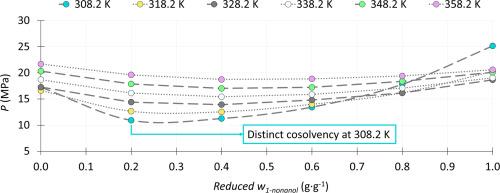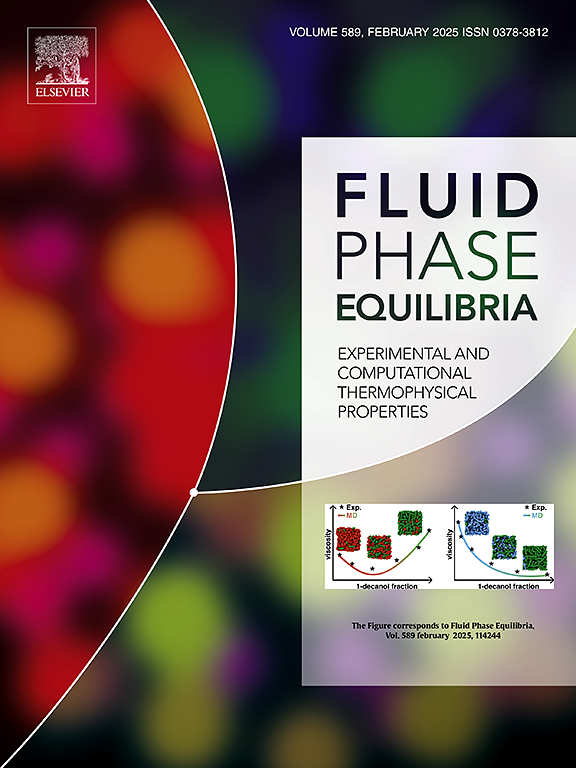1 -壬醇+正十六烷+超临界CO2体系的高压相行为和建模
IF 2.7
3区 工程技术
Q3 CHEMISTRY, PHYSICAL
引用次数: 0
摘要
这项工作提出了含有1 -壬醇+正十六烷(溶质+溶质)和超临界CO2(溶剂)的混合物的高压相变数据和测量数据的热力学建模。在温度为308.2 K ~ 358.2 K,溶质质量分数为0.008 ~ 0.65 g·g-1的条件下,采用静态合成目测相法测量了四种(1 -壬醇+正十六烷)与CO2以及1 -壬醇+ CO2的混合物的数据。溶质-溶质相互作用强烈影响观察到的相行为,导致复杂的现象,如共溶效应和温度反转。无溶剂酒精组分0 g·g-1、0.8 g·g-1和1 g·g-1在308.2 K和318.2 K温度下呈现出明显的共溶效应。在Aspen Plus®中实现的Soave-Redlich-Kwong (SRK)状态方程的改进版本RK - Aspen用于关联实验纯组分和二元数据,并预测三元体系的高压相变数据。在RK-Aspen模型中加入极性参数、溶质-溶剂二元相互作用参数(BIPs)和溶质-溶质二元相互作用参数(BIPs),可以合理准确地描述中温露点和泡点组成范围内的测量数据。然而,未来的工作应该集中在提高模型在溶剂临界温度附近的性能和混合物临界区域附近的成分。此外,可以开发内部热力学模型来更好地描述复杂的相行为。本文章由计算机程序翻译,如有差异,请以英文原文为准。

High-pressure phase behaviour and modelling of the 1‑nonanol + n‑hexadecane + supercritical CO2 system
This work presents measured high-pressure phase transition data for mixtures containing 1‑nonanol + n‑hexadecane (solute + solute) with supercritical CO2 (solvent) and thermodynamic modelling of the measured data. The data was measured using the static synthetic visual phase method for four (1‑nonanol + n‑hexadecane) mixtures with CO2 as well as 1‑nonanol + CO2 at temperatures between 308.2 K and 358.2 K and solute mass fractions ranging from 0.008 to 0.65 g·g-1. Solute-solute interactions strongly influence the observed phase behaviour, resulting in complex phenomena such as cosolvency effects and temperature inversions. The measured data revealed distinct cosolvency effects and exhibited temperature inversions at 308.2 K and 318.2 K for solvent-free alcohol compositions of 0 g·g-1, 0.8 g·g-1 and 1 g·g-1.
A modified version of the Soave-Redlich-Kwong (SRK) equation of state implemented in Aspen Plus®, RK‑Aspen, was used to correlate experimental pure component and binary data, and to predict the high-pressure phase transition data for the ternary system. Incorporating polar parameters, solute-solvent binary interaction parameters (BIPs), and solute-solute BIPs in the RK-Aspen model provided reasonably accurate descriptions of the measured data in the dew- and bubble point composition ranges at moderate temperatures. However, future work should focus on improving the model's performance at temperatures near the solvent's critical temperature and compositions near the mixture critical region. Additionally, an in-house thermodynamic model can be developed to better describe complex phase behaviour.
求助全文
通过发布文献求助,成功后即可免费获取论文全文。
去求助
来源期刊

Fluid Phase Equilibria
工程技术-工程:化工
CiteScore
5.30
自引率
15.40%
发文量
223
审稿时长
53 days
期刊介绍:
Fluid Phase Equilibria publishes high-quality papers dealing with experimental, theoretical, and applied research related to equilibrium and transport properties of fluids, solids, and interfaces. Subjects of interest include physical/phase and chemical equilibria; equilibrium and nonequilibrium thermophysical properties; fundamental thermodynamic relations; and stability. The systems central to the journal include pure substances and mixtures of organic and inorganic materials, including polymers, biochemicals, and surfactants with sufficient characterization of composition and purity for the results to be reproduced. Alloys are of interest only when thermodynamic studies are included, purely material studies will not be considered. In all cases, authors are expected to provide physical or chemical interpretations of the results.
Experimental research can include measurements under all conditions of temperature, pressure, and composition, including critical and supercritical. Measurements are to be associated with systems and conditions of fundamental or applied interest, and may not be only a collection of routine data, such as physical property or solubility measurements at limited pressures and temperatures close to ambient, or surfactant studies focussed strictly on micellisation or micelle structure. Papers reporting common data must be accompanied by new physical insights and/or contemporary or new theory or techniques.
 求助内容:
求助内容: 应助结果提醒方式:
应助结果提醒方式:


